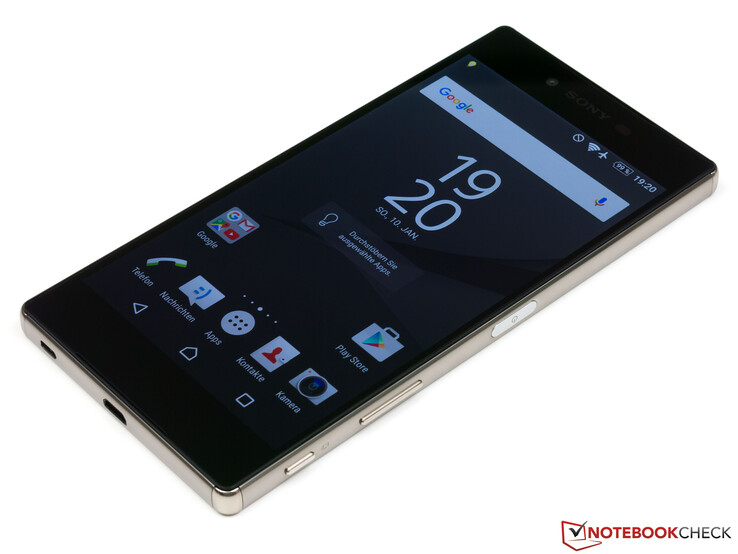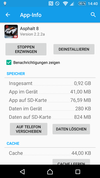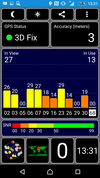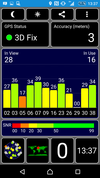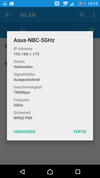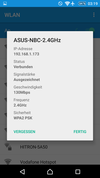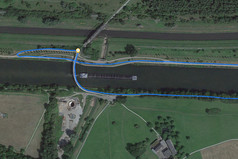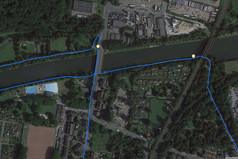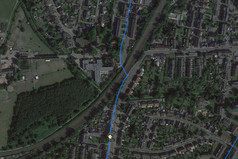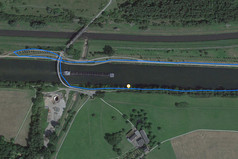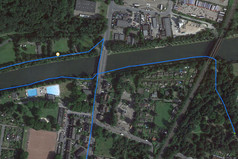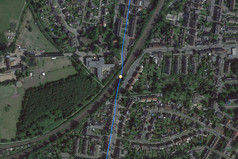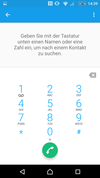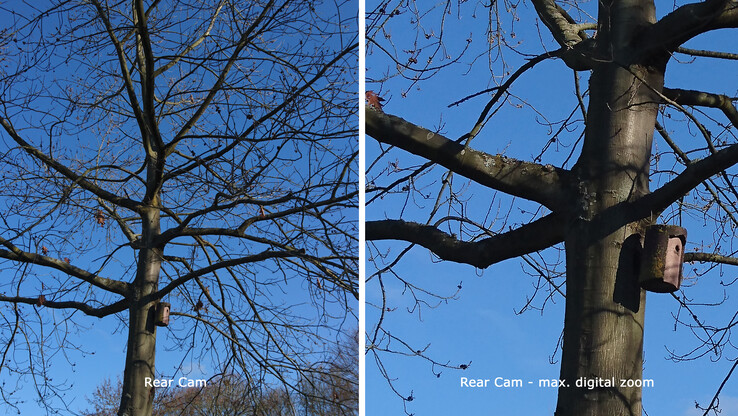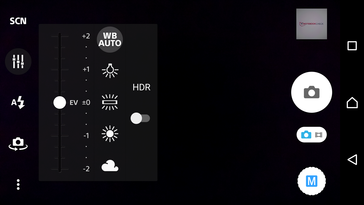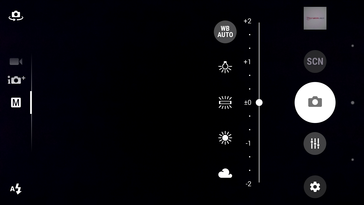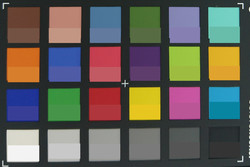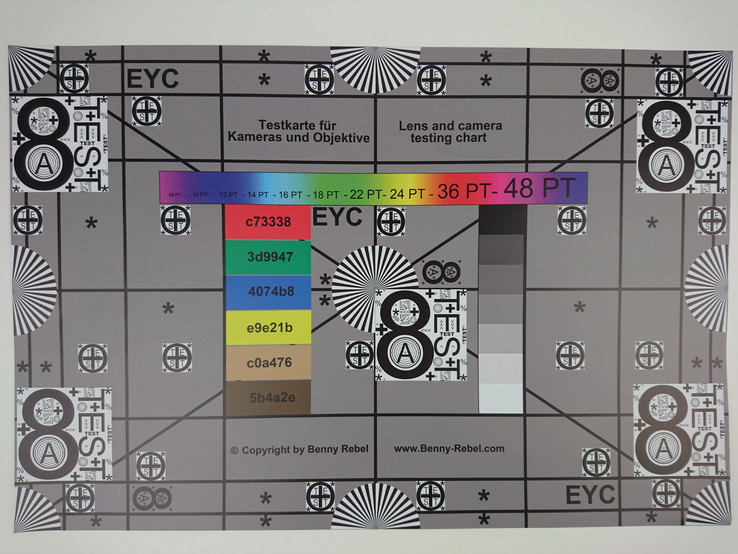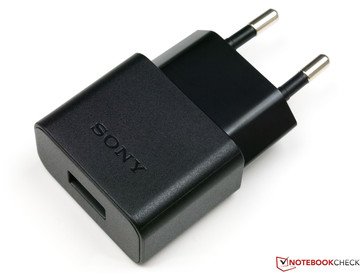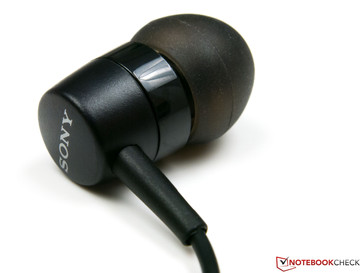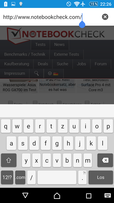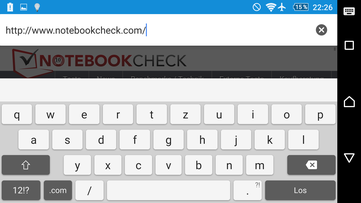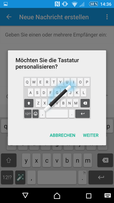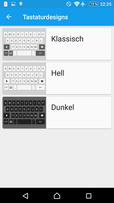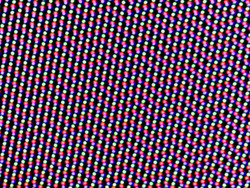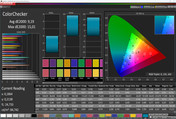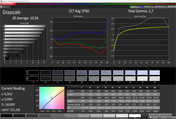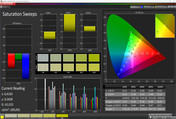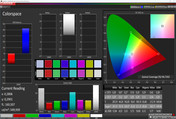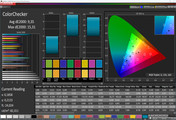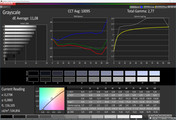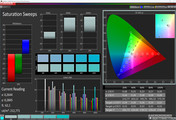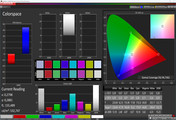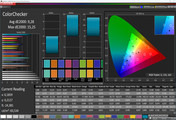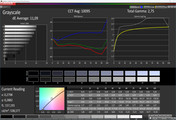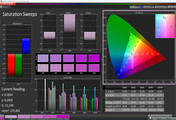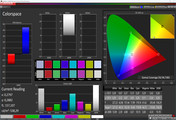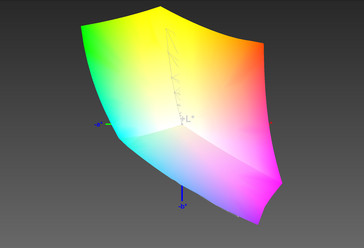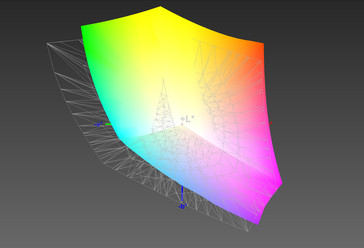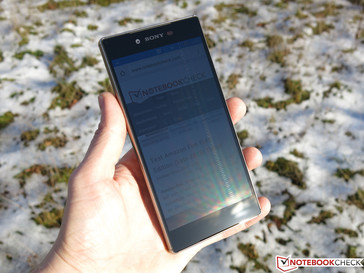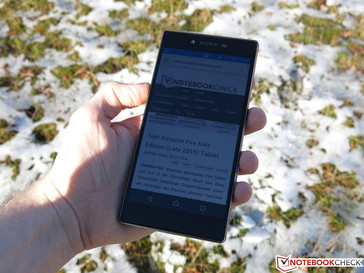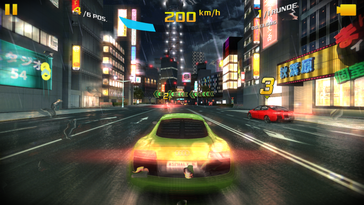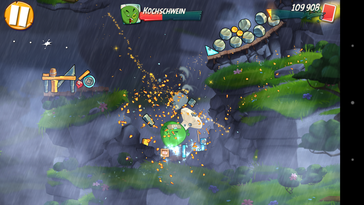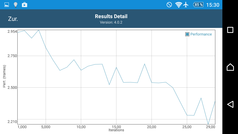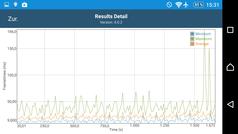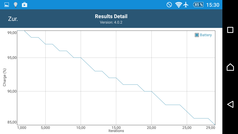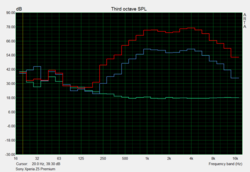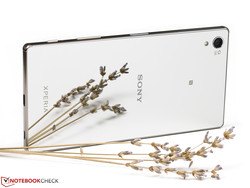Sony Xperia Z5 Premium Smartphone Review
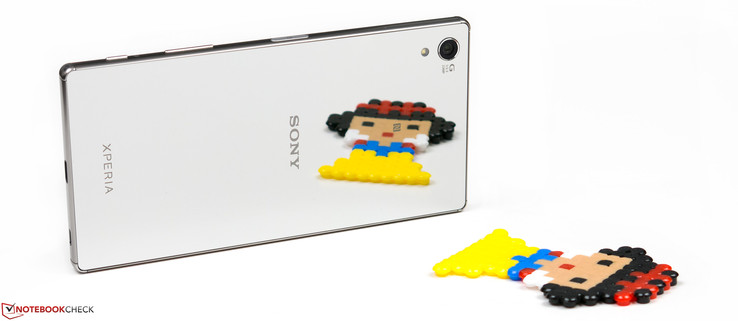
For the original German review, see here.
In addition to the Xperia Z5 and Xperia Z5 Compact smartphones that we examined closely, Sony now has a somewhat bigger model with a 5.5-inch screen called Xperia Z5 Premium. It has many components in common with its siblings: All are powered by Qualcomm's Snapdragon 810 SoC, have a convenient fingerprint scanner incorporated in the power button, and sport the same camera modules. The top model's unique selling point is its extremely high-resolution ultra HD screen - this panel type has not been used in the smartphone world to date. Buyers who want to call this novelty their own will have to dig deep into their pockets. A minimum of 700 Euros (~$763) is presently demanded for the handset (listed price: 779 Euros/~$849), placing the smartphone in the premium league in this respect. The storage capacity of 32 GB is not variable, but the buyer can choose from three colors (chrome, gold and black). Furthermore, a dual-SIM model is available in other markets.
The flagships from the competition can be seen as the Z5 Premium's rivals. Among them we find Google's new Nexus 6P as well as established models like LG's G4, Huawei's Mate S and Samsung's Galaxy S6 Edge. Primarily Apple's iPhone 6S Plus and the Windows-based Microsoft Lumia 950 XL are strong opponents outside the Android cosmos.
Case
Fans of high-quality materials will shed tears of joy when seeing the Z5 Premium: While the lateral edges are composed of metal, the entire front and back sides are covered by glass. It has been chemically tempered and coated with a fingerprint resistant finish, at least in the screen's area. The spec sheets do not reveal what kind of glass has been used for the back, but there is no subjective difference to the material on the front. Unlike the elegant-looking, matte back cover of the smaller Xperia Z5, our chrome-colored review sample could also be mistaken for a pocket mirror. It is obvious that this design also involves drawbacks. Its surface is covered with some fingerprints after only a short time. They are, however, quite easy to remove. The feel of the applied materials does not give reason for complaint. However, the lateral edges give an otherwise standard design some character. The non-removable battery is difficult to replace, which is a negative point.
The now bigger 5.5-inch screen has an effect on the casing's size: Compared with a normal Xperia Z5, the Premium model has larger dimensions. The handset's length also demonstrates that compactness was not a priority in the device's development. It clearly towers over many 5.5-inch rivals, such as LG's G4 or Huawei's Mate S. This additional space is visible in the relatively tall, unused areas above and below the screen. Some opponents like Apple's iPhone 6S Plus or Google's Nexus 6P with a larger 5.7-inch screen are even bigger. The Xperia Z5 Premium has a thickness of 7.8 millimeters (~0.3 in) according to the manufacturer, which is true in the glass surface areas. We measure marginal 0.3 millimeters more on our review sample's slightly protruding metal frame. In contrast to many competing models, the camera is fortunately flush with the casing. Although the handset is not the slimmest smartphone on the market with these dimensions, it is still relatively thin. Its weight of 181 grams (~6.4 oz) does not necessarily reflect that; only the iPhone 6S Plus is even heavier with 192 grams (~6.8 oz) in the comparison field. Thus, it projects a certain degree of quality.
In contrast to unibody handsets, the Xperia Z5 Premium is much easier to twist. However, it does not produce any disconcerting noises. Waves form on the screen only when higher pressure is applied to the device's front or back. Like other handsets in the Z5 lineup, the review sample is water and dust resistant in accordance to IP65 and IP68 - it should not be exposed to salt or chlorinated water, though. Therefore, care should be taken when visiting the beach or swimming pool.
Connectivity
The Z5 Premium's interfaces are the same as in the smaller Z5 model. It features 3 GB of RAM, Qualcomm's Snapdragon 810 SoC and 32 GB of internal storage that can be expanded by up to 200 GB via the micro-SD slot. Approximately 21.5 GB of internal storage are available in delivery state. A metal flap on the casing left has to be opened for replacing the memory card. A relatively fragile plastic tray with recesses for a nano-SIM card and micro-SD card, as well as the extensible model plate with CE marking hides behind that. It is more or less easy to access depending on the length of the fingernails. The handset inevitably reboots when the tray is pulled out or inserted. It is possible to move apps to the external storage device providing they are programmed accordingly.
Despite the premium claim, the review sample does not sport a modern, double-sided USB Type C port like found in Google's Nexus 6P, for example. The classic micro-USB port supports video output via MHL 3.0 and peripherals can be connected via USB OTG. The user first has to look for the device manually via the "Device Connection" menu and the sub-item "USB connectivity".
Wireless transmission of content is also possible via Google Cast, DLNA or Miracast. Video output to a TV via screen mirroring was easily possible in our practical test using an Amazon Fire TV stick, however audio was not transmitted. Media streaming to certified end devices via DLNA was absolutely no problem. Beyond that, the smartphone supports NFC and Bluetooth 4.1. A small yet highly visible multicolor notification LED in the upper left corner, an FM radio and a reliable fingerprint scanner incorporated in the power button round off the handset's extensive configuration.
Software
Sony's user interface only subtly expands Android 5.1.1 by some useful additional features. Besides some smaller visual modifications and preloaded designs, there are a few new additional features such as a favorite bar when opening the recently used app view. In total, the modifications are kept within very tight limits - everyone who is familiar with stock Android will manage well right away. An update to Android 6.0 Marshmallow has been announced.
Unlike in Nexus handsets, multiple apps are preloaded on the Z5 Premium ex-factory. In addition to programs developed by Sony that, for example, enable Remote Play on the PlayStation 4, many third-party apps are found on the smartphone (e.g. Facebook, Sky Go, AVG Protection, Dropbox, etc.). However, except for the file manager "File Commander", all latter named can be uninstalled when not required.
The "Album" and "Video" apps play a special role in the Z5 Premium. The ultra HD panel can only really be used with them. As Sony clarified prior to market launch in the company's blog, all content is normally only calculated in Full HD and scaled up accordingly. However, photos and videos shot with the smartphone and 4K videos from streaming services are exceptions. Photos are in fact displayed in the screen's native resolution when looking at them with Sony's app. In a direct comparison with a 5.5-inch QHD panel, a small improvement is actually visible in details although the screen has to be viewed from an unnaturally close distance. A side effect of this pixel torrent: The Album app needs approximately 4 seconds to open every photo completely using enabled image optimizer before the screen can display its full potential.
Communication & GPS
Bluetooth version 4.1 is installed in the Xperia Z5 Premium for wireless near field communication. The review sample did not show weaknesses when using a Bluetooth mouse or transmitting data to other smartphones. The integrated Wi-Fi module supports the modern AC standard, and theoretically achieves data rates of up to 866 Mbit/s in the 5 GHz band thanks to MIMO technology. The component displayed very good reception qualities in the test with an Asus RT AC56U router; the results were rather middling in the 5 GHz frequency.
The Xperia Z5 Premium connects to mobile networks via quad-band GSM, UMTS and LTE Cat. 6 (13 frequencies; max. 300 Mbit/s download, 50 Mbit/s upload) on the move. Consequently, globetrotters should hardly have problems with network coverage. The reception in an urban area in the T-Mobile network was impeccable.
The smartphone utilizes GPS, GLONASS and BeiDou for localization. The current position was tracked down to 3 meters (~10 feet) outdoors quickly and accurately. The review sample also managed that quickly in a one-story supermarket. The direct comparison with the Garmin Edge 500 GPS bike computer shows that the Z5 Premium traces the route a bit less accurately in detail, which primarily leads to small discrepancies in difficult places like underpasses and in the area of power poles. However, that should be rather insignificant for navigation applications.
Telephone & Call Quality
Although the functionality of Sony's phone app does not differ from Google's stock solution, favorites and the call list are compiled in one view rather than on dedicated screens. As usual, a search box for finding contacts quickly is situated in the screen's upper third. A keypad can be opened via a button in the screen's lower area.
The Xperia Z5 Premium managed good voice quality in our test calls in the T-Mobile network. The smartphone user was impeccably audible without static on the landline side in both hands-free mode and during normal calls. The contact's voice was also always loud and clear via the smartphone's earpiece. The contact sounded a bit less natural when using the stereo speakers, but intelligibility did not decrease. The maximum volume is relatively low for use in noisier environments. The included headset convinced with good call quality at both ends in the test.
An unusual feature is found in the call settings: The feature "Slow Talk", which slows down the contact's speech a bit without distorting the voice when enabled. This option might prove useful when making calls in difficult conditions.
Cameras & Multimedia
Like in other models in the Xperia Z5 lineup, Sony installs its newly developed 1/2.3-inch Exmore sensor with 23 megapixels in the Xperia Z5 Premium. The primary camera has good preconditions for above-average image quality with this relatively large lens, wide f/2.0 lens and a focal point of 24 millimeters (~1 inch, equal to small-size pictures). It is striking that the 16:9 photos are not just sections of the 4:3 photo. Instead, additional image sections are captured in one axis while information is omitted in the other. The available sensor surface is thus never fully utilized.
Unfortunately, some weaknesses become evident in the practical test despite cutting edge technology. The photos display a good sharpness in daylight, but it decreases visibly toward the photo's edge even under these ideal conditions depending on the object (e.g. scene 1). Some competing products, such as Apple's iPhone 6S Plus, show a better performance. Furthermore, image noise caused by the sensor's higher sensitivity in low-light conditions is reduced via soft-focus. The camera in the Z5 Premium can brighten up dim environments with a simple LED flash. Although its brightness is clearly higher than in flashlight mode, it cannot quite compete with the dual-LED solutions in many higher-priced rivals. The photos often display a purplish tint at the edges when taken without the flash or in twilight or at night when the objects are too far away (e.g. scene 3).
The Xperia Z5 Premium collects plus points with its fast hybrid focus that enables quick release times. The physical release button with two clearly separated pressure points (focus and shot) also contributes to an especially comfortable handling. It can also be used to quick-start the camera app from standby.
The front-facing webcam also benefits from that. It is furnished with 5 megapixels and a 25-millimeter lens (~ 1 inch, equal to small-size pictures). Although distant objects are somewhat blurred due to the lack of auto focus, the camera produces useful selfie photos.
Panning panoramas with the Xperia Z5 is also possible. However, they suffer under heavy blurriness even when following the recording instructions closely. Furthermore, outcomes that are not distorted by errors at the edges are rarely possible.
The primary camera records videos in sharp 3840x2160 pixels at 30 frames per second maximum. An image stabilizer (SteadyShot) ensures surprisingly blur-free clips when Full HD videos are enough for the user. This resolution is also the webcam's maximum for videos. The videos are very convincing for a front camera thanks to their smooth playback and sufficient sharpness at close distances. Audio tracks present good-sounding stereo sound.
The camera app was updated during the test period, which clearly altered the user interface. Selecting various modes was possible via a button in the lower right edge in factory state. That is now possible via a bar in the app's left area or via vertical swiping in the new software version. The additional video button in the "Manual" and "Superior Auto" modes has also been axed, making it necessary to always switch to the intended mode when recording videos. The multiple setting options and effect filters are positive, although they often involve restrictions. For example, the ISO sensitivity can only be adapted up to an image size of 8 megapixels in manual mode. Using effect filters results in Full HD shots.
Color Accuracy & Sharpness
We compare the photo of the X-Rite ColorChecker Passport with the factual reference color under controlled lighting conditions to test the color accuracy of the Xperia Z5 Premium's primary camera. The photos are not edited - e.g. manual white balance - afterwards.
The screenshot clearly shows that the camera has a well-functioning color management. The color hues are quite close to the reference value in most cases. Only large brightness shifts are seen in turquoise, cyan and light gray.
We take an edge-to-edge picture of our test chart in artificial light to assess the image sharpness. It is again seen that the image sharpness decreases from the center to the edges. This is primarily even more evident in the sample pictures taken in vegetation. Minor distortions are also visible.
Accessories
Despite the very promising addendum "Premium", the accessories included for the review sample is not very different from that of many other smartphones. Although the in-ear headset shines with a decent sound and useful microphone, the power supply with only 7.5 watts (5 V, 1.5 A) is somewhat undersized in this price range. Thus, it is not surprising that Sony has a quick charger in its lineup that, however, adds 29 Euros (~$32) to the price. Furthermore, a window case specially designed for the Xperia Z5 Premium is available for 39 Euros (~$43); it covers both the front and back sides.
Warranty
Warranty information for the review sample was not included. However, according to Sony's homepage, mobile devices are shipped with a two-year warranty. That is limited to one year for the original, included accessories and the non-removable battery.
Input Devices & Handling
The Xperia keyboard is enabled by default for entering text. Its base setting is very plain. However, various options for customization are available so that, for example, a number row and second assignment icons can be faded in when required. Compared with Google's stock layout, the lower letter row is a bit more cramped, which was not a drawback during use. Typing even long sentences was easy thanks to the large and accurate touchscreen.
All physical keys feature a good pressure point and are installed firmly enough in the casing. The lowered power button also serves as an easy to reach, reliable fingerprint scanner. However, just placing the finger on it does not activate the handset. The key has to be pressed to wake it up from standby. This fast unlocking solution proved very convenient in routine use.
As expected from a premium-range smartphone, the operating system always ran smoothly in the test thanks to its high-performance hardware. The home screen is displayed instantaneously even when sophisticated programs are closed suddenly.
Display
According to Sony, the Xperia Z5 Premium is the first smartphone to feature an ultra HD panel. The screen has a resolution of 3840x2160 pixels on a diagonal of 5.5 inches. Its pixel density of over 800 PPI outshines Samsung's high-end Galaxy S6 Edge (576 PPI) at least in figures, for example. However, the ultra HD panel only really utilizes its full resolution when looking at photos or watching videos. The screen renders all other content only in a scaled up Full HD resolution. Whether this torrent of pixels makes sense is controversial since there is virtually no visible difference in routine use - it only becomes evident at a very close distance and when directly compared with other premium smartphones.
The review sample achieves a brightness of 540.8 cd/m² in the center of a completely white screen. This is a good but not outstanding outcome compared with the competition. For example, the smaller Xperia Z5 has an even brighter screen. The resulting contrast of 1244:1 is decent, and it is on par with other rivals furnished with an IPS panel. The rates only vary marginally when the automatic brightness control is activated. However, the measurements performed with equally distributed bright and dark areas on the screen are more significant (average picture level / APL 50). The review sample reaches a much worse outcome of 426 cd/m², almost nullifying the difference to the presumed inferior rivals - such as Google's Nexus 6P - in these tests. Furthermore, the contrast drops to poor 961:1, and the illumination of 85% is rather middling.
| |||||||||||||||||||||||||
Brightness Distribution: 85 %
Center on Battery: 560 cd/m²
Contrast: 1244:1 (Black: 0.45 cd/m²)
ΔE ColorChecker Calman: 9.19 | ∀{0.5-29.43 Ø4.77}
ΔE Greyscale Calman: 10.58 | ∀{0.09-98 Ø5}
99.41% sRGB (Calman 2D)
73.19% AdobeRGB 1998 (Argyll 1.6.3 3D)
82% AdobeRGB 1998 (Argyll 3D)
99.5% sRGB (Argyll 3D)
90.2% Display P3 (Argyll 3D)
Gamma: 2.7
CCT: 9760 K
Screen Flickering / PWM (Pulse-Width Modulation)
| Screen flickering / PWM not detected | ||
In comparison: 53 % of all tested devices do not use PWM to dim the display. If PWM was detected, an average of 8081 (minimum: 5 - maximum: 343500) Hz was measured. | ||
| Sony Xperia Z5 Premium 3840x2160 px 5.5'' (IPS) | Sony Xperia Z5 1920x1080 px 5.2'' (IPS) | Google Nexus 6P 2560x1440 px 5.7'' (AMOLED) | LG G4 2560x1440 px 5.5'' (IPS) | Huawei Mate S 1920x1080 px 5.5'' (IPS) | Samsung Galaxy S6 Edge 2560x1440 px 5.1'' (AMOLED) | Apple iPhone 6S Plus 1920x1080 px 5.5'' (IPS) | Microsoft Lumia 950 XL 2560x1440 px 5.7'' (AMOLED) | |
|---|---|---|---|---|---|---|---|---|
| Screen | -4% | 21% | 8% | 3% | 18% | 15% | 18% | |
| Brightness middle (cd/m²) | 560 | 669 19% | 363 -35% | 566 1% | 352 -37% | 343 -39% | 583 4% | 297 -47% |
| Brightness (cd/m²) | 541 | 624 15% | 365 -33% | 536 -1% | 350 -35% | 338 -38% | 560 4% | 297 -45% |
| Brightness Distribution (%) | 85 | 85 0% | 90 6% | 90 6% | 87 2% | 94 11% | 91 7% | 93 9% |
| Black Level * (cd/m²) | 0.45 | 0.68 -51% | 0.47 -4% | 0.46 -2% | ||||
| Contrast (:1) | 1244 | 984 -21% | 1204 -3% | 1267 2% | ||||
| Colorchecker dE 2000 * | 9.19 | 7.96 13% | 2.34 75% | 6.17 33% | 4.95 46% | 2.2 76% | 3.55 61% | 2.67 71% |
| Colorchecker dE 2000 max. * | 15.01 | 3.98 73% | ||||||
| Greyscale dE 2000 * | 10.58 | 10.95 -3% | 1.03 90% | 6.26 41% | 6.54 38% | 2.37 78% | 3.88 63% | 2.81 73% |
| Gamma | 2.7 81% | 2.61 84% | 2.23 99% | 2.48 89% | 2.27 97% | 2.41 91% | 2.2 100% | 2.08 106% |
| CCT | 9760 67% | 7402 88% | 6429 101% | 8171 80% | 6943 94% | 6425 101% | 7280 89% | 6379 102% |
| Color Space (Percent of AdobeRGB 1998) (%) | 73.19 | 65.48 -11% | 87.77 20% | 59.05 -19% | 66.31 -9% | |||
| Color Space (Percent of sRGB) (%) | 98.63 | 92.8 | 99.79 |
* ... smaller is better
The user generally has three options for image optimizing: "X-Reality for mobile", "live color" and "off". Differences between these modes are primarily seen in color saturation. Deficits in color reproduction are common for all modes. The average DeltaE shift of at best 9.19 (mixed colors) and 10.58 (grayscale) are remote from the ideal (DeltaE <3). That is also true for the gamma rate of approximately 2.7 (ideal: 2.2) and color temperature of approximately 10,000 K (ideal: 6,500 K). In any case, these rates lead to a visible bluish tint that is particularly evident in the grayscale. These unimpressive rates place the Xperia Z5 Premium in last place in the competition field. The heavy bluish tint is primarily striking in a direct comparison with other screens subjectively. The color looks very vivid with enabled image optimization otherwise. However, similar to other devices in the Xperia lineup, the screen can be improved via manual white balance.
Something good can be said again in terms of the AdobeRGB color space coverage: With a rate of 73.19%, the review sample places itself even before Apple's iPhone 6S Plus, Microsoft's Lumia 950 XL and LG’s G4. It cannot quite hold a candle to Samsung's Galaxy S6 Edge furnished with an AMOLED panel.
The screen remains easily legible outdoors as long as direct reflections are not seen on the screen's panel. The device should not reach very high temperatures because they lead to a clear brightness reduction. For example, this dimming occurred while playing "Asphalt 8" in a sunlit room. Although other smartphones, such as LG's G4, display a similar behavior, the reduction is made visible. Sony's smartphone indicates that it is still shining at full brightness. We observed this mannerism half a year ago in Sony's Xperia Z3+.
Performance
Like in the entire Xperia Z5 lineup, Qualcomm's Snapdragon 810 SoC is also installed in the premium model. The upper-range SoC is designed in ARM's big.LITTLE architecture and has four frugal Cortex A53 cores (max. 1.5 GHz) and four fast Cortex A57 cores (max. 2.0 GHz). Beyond that, the processor can fall back on 3 GB of working memory.
The Xperia Z5 Premium presents very good performance in many benchmarks that are sometimes even slightly better than that of rivals based on the same SoC. Only Samsung's Galaxy S6 Edge can boast with better scores throughout. Apple's iPhone 6S Plus also leads the way in the single-core performance test of Geekbench 3. However, the placing of the review samples in AndEBench PRO is conspicuous: The Xperia Z5 Premium ends up behind LG's G4 although it has a marginally slower SoC. A reason might be the SoC's throttling behavior that generally leads to increasingly deteriorating results when the benchmark is performed multiple times in succession.
| AnTuTu v5 - Total Score (sort by value) | |
| Sony Xperia Z5 Premium | |
| Sony Xperia Z5 | |
| Google Nexus 6P | |
| LG G4 | |
| Huawei Mate S | |
| Samsung Galaxy S6 Edge | |
| Apple iPhone 6S Plus | |
| PCMark for Android - Work performance score (sort by value) | |
| Sony Xperia Z5 Premium | |
| Sony Xperia Z5 | |
| Google Nexus 6P | |
| LG G4 | |
| Huawei Mate S | |
| Samsung Galaxy S6 Edge | |
| ANDEBench PRO | |
| 3D (sort by value) | |
| Sony Xperia Z5 Premium | |
| LG G4 | |
| Samsung Galaxy S6 Edge | |
| Platform (sort by value) | |
| Sony Xperia Z5 Premium | |
| LG G4 | |
| Samsung Galaxy S6 Edge | |
| Memory Latency (sort by value) | |
| Sony Xperia Z5 Premium | |
| LG G4 | |
| Samsung Galaxy S6 Edge | |
| Memory Bandwidth (sort by value) | |
| Sony Xperia Z5 Premium | |
| LG G4 | |
| Samsung Galaxy S6 Edge | |
| CoreMark-PRO/HPC (Base) (sort by value) | |
| Sony Xperia Z5 Premium | |
| LG G4 | |
| Samsung Galaxy S6 Edge | |
| Device Score (sort by value) | |
| Sony Xperia Z5 Premium | |
| LG G4 | |
| Samsung Galaxy S6 Edge | |
| PassMark PerformanceTest Mobile V1 | |
| 3D Graphics Tests (sort by value) | |
| Sony Xperia Z5 Premium | |
| LG G4 | |
| Samsung Galaxy S6 Edge | |
| Apple iPhone 6S Plus | |
| 2D Graphics Tests (sort by value) | |
| Sony Xperia Z5 Premium | |
| LG G4 | |
| Samsung Galaxy S6 Edge | |
| Apple iPhone 6S Plus | |
| Memory Tests (sort by value) | |
| Sony Xperia Z5 Premium | |
| LG G4 | |
| Samsung Galaxy S6 Edge | |
| Apple iPhone 6S Plus | |
| CPU Tests (sort by value) | |
| Sony Xperia Z5 Premium | |
| LG G4 | |
| Samsung Galaxy S6 Edge | |
| Apple iPhone 6S Plus | |
| System (sort by value) | |
| Sony Xperia Z5 Premium | |
| LG G4 | |
| Samsung Galaxy S6 Edge | |
| Apple iPhone 6S Plus | |
The Adreno 430 GPU responsible for video output does a good job and - with the exception of Basemark X 1.1 - places the review sample up front before all Android rivals. The comparatively resource-sparing internal calculation in the Full HD rather than ultra HD resolution likely contributes to that in many benchmarks. Only Apple's iPhone 6S Plus achieves even better outcomes.
| GFXBench 3.1 | |
| 1920x1080 Manhattan ES 3.1 Offscreen (sort by value) | |
| Sony Xperia Z5 Premium | |
| Sony Xperia Z5 | |
| Google Nexus 6P | |
| LG G4 | |
| Huawei Mate S | |
| Samsung Galaxy S6 Edge | |
| Apple iPhone 6S Plus | |
| on screen Manhattan ES 3.1 Onscreen (sort by value) | |
| Sony Xperia Z5 Premium | |
| Sony Xperia Z5 | |
| Google Nexus 6P | |
| LG G4 | |
| Huawei Mate S | |
| Samsung Galaxy S6 Edge | |
| Apple iPhone 6S Plus | |
| GFXBench 3.0 | |
| 1920x1080 1080p Manhattan Offscreen (sort by value) | |
| Sony Xperia Z5 Premium | |
| Sony Xperia Z5 | |
| Google Nexus 6P | |
| LG G4 | |
| Huawei Mate S | |
| Samsung Galaxy S6 Edge | |
| Apple iPhone 6S Plus | |
| Microsoft Lumia 950 XL | |
| on screen Manhattan Onscreen OGL (sort by value) | |
| Sony Xperia Z5 Premium | |
| Sony Xperia Z5 | |
| Google Nexus 6P | |
| LG G4 | |
| Huawei Mate S | |
| Samsung Galaxy S6 Edge | |
| Apple iPhone 6S Plus | |
| Microsoft Lumia 950 XL | |
| Lightmark - 1920x1080 1080p (sort by value) | |
| Sony Xperia Z5 Premium | |
| LG G4 | |
| Samsung Galaxy S6 Edge | |
| Epic Citadel - Ultra High Quality (sort by value) | |
| Sony Xperia Z5 Premium | |
| LG G4 | |
| Samsung Galaxy S6 Edge | |
| Basemark X 1.1 | |
| High Quality (sort by value) | |
| Sony Xperia Z5 Premium | |
| Samsung Galaxy S6 Edge | |
| Medium Quality (sort by value) | |
| Sony Xperia Z5 Premium | |
| Samsung Galaxy S6 Edge | |
| Microsoft Lumia 950 XL | |
A similar impression is also conveyed in the browser tests. While Apple's iPhone 6S Plus remains unmatched, only Samsung's Galaxy S6 Edge offers a slightly higher performance than the Xperia Z5 Premium among the Android-based handsets.
| Octane V2 - Total Score (sort by value) | |
| Sony Xperia Z5 Premium | |
| Sony Xperia Z5 | |
| Google Nexus 6P | |
| LG G4 | |
| Huawei Mate S | |
| Samsung Galaxy S6 Edge | |
| Apple iPhone 6S Plus | |
| Microsoft Lumia 950 XL | |
| Sunspider - 1.0 Total Score (sort by value) | |
| Sony Xperia Z5 Premium | |
| Sony Xperia Z5 | |
| Google Nexus 6P | |
| LG G4 | |
| Huawei Mate S | |
| Samsung Galaxy S6 Edge | |
| Apple iPhone 6S Plus | |
| Microsoft Lumia 950 XL | |
| Mozilla Kraken 1.1 - Total (sort by value) | |
| Sony Xperia Z5 Premium | |
| Sony Xperia Z5 | |
| Google Nexus 6P | |
| LG G4 | |
| Huawei Mate S | |
| Samsung Galaxy S6 Edge | |
| Apple iPhone 6S Plus | |
| Microsoft Lumia 950 XL | |
| WebXPRT 2015 - Overall (sort by value) | |
| Sony Xperia Z5 Premium | |
| Sony Xperia Z5 | |
| Google Nexus 6P | |
| LG G4 | |
| Huawei Mate S | |
| Apple iPhone 6S Plus | |
| Microsoft Lumia 950 XL | |
| Google V8 Ver. 7 - Google V8 Ver. 7 Score (sort by value) | |
| Sony Xperia Z5 Premium | |
| Sony Xperia Z5 | |
| Google Nexus 6P | |
| LG G4 | |
| Samsung Galaxy S6 Edge | |
| Apple iPhone 6S Plus | |
| Microsoft Lumia 950 XL | |
| JetStream 1.1 - Total Score (sort by value) | |
| Sony Xperia Z5 Premium | |
| Sony Xperia Z5 | |
| Google Nexus 6P | |
| LG G4 | |
| Huawei Mate S | |
| Samsung Galaxy S6 Edge | |
| Apple iPhone 6S Plus | |
| Microsoft Lumia 950 XL | |
| Browsermark - 2.1 (sort by value) | |
| Sony Xperia Z5 Premium | |
| LG G4 | |
| Samsung Galaxy S6 Edge | |
| Apple iPhone 6S Plus | |
| Microsoft Lumia 950 XL | |
| Vellamo 3.x - Browser (sort by value) | |
| Sony Xperia Z5 Premium | |
| LG G4 | |
| Samsung Galaxy S6 Edge | |
* ... smaller is better
Although the AndroBench storage tests show that the poor results of the smaller Xperia Z5 in "random read 4K" do not affect the premium model as heavily, the performance gain is not enough to stand up against the strong competition. The other measurements deliver very mixed results. While the review sample is only surpassed by Samsung's Galaxy S6 Edge in sequential read, it ends up last place in sequential write. Its behavior in random write places it midfield.
The other benchmarks also indicate a weakness of the installed storage where the Xperia Z5 Premium and its technological twin - Xperia Z5 - are always in last place.
Rates of approximately 22 MB/s were reached when transmitting files from the PC to the smartphone's internal storage via USB cable. Around 26 MB/s were possible in the other direction. Both are not good results even for the underlying USB 2.0 standard.
We also tested the micro-SD slot's speed with our Toshiba Exceria SD-CX32UHS1 memory card (UHS-I Class 3, max. read: 85 MB/s, max. write: 50 MB/s). The results for both sequential read (17.42 MB/s) and write (11.21 MB/s) clearly remain behind the memory card's potentials. The interface is also weak in random read (7.19 MB/s) and random write (0.11 MB/s).
| BaseMark OS II - Memory (sort by value) | |
| Sony Xperia Z5 Premium | |
| Sony Xperia Z5 | |
| Google Nexus 6P | |
| LG G4 | |
| Huawei Mate S | |
| Samsung Galaxy S6 Edge | |
| Apple iPhone 6S Plus | |
| Microsoft Lumia 950 XL | |
| PassMark PerformanceTest Mobile V1 - Disk Tests (sort by value) | |
| Sony Xperia Z5 Premium | |
| LG G4 | |
| Samsung Galaxy S6 Edge | |
| Apple iPhone 6S Plus | |
| ANDEBench PRO - Storage (sort by value) | |
| Sony Xperia Z5 Premium | |
| LG G4 | |
| Samsung Galaxy S6 Edge | |
Games
The Adreno 430 GPU in the Xperia Z5 Premium always ensures smooth gameplay thanks to the internal graphic calculation in the Full HD resolution. Both restrained games, such as "Angry Birds 2" as well as graphically demanding games like "Asphalt 8" can be enjoyed without lags in high quality. Furthermore, the integrated position sensors and the accurate touchscreen function extremely reliably in games. Beyond that, it is a pleasure to find the front-sided speaker is not covered by the hands when the smartphone is held in landscape mode.
Emissions
Temperature
A bigger casing usually makes it possible to cool the installed components more efficiently. The Xperia Z5 Premium has the upper hand on its smaller siblings here. However, it soon becomes clear that the review sample cannot utilize this advantage. While it reaches similar idle temperatures of 31 to 34 °C (87.8 to 93.2 °F) as the smaller Xperia Z5, the average load rates of over 40 °C (104 °F) are much higher. The maximum temperatures are not critical since the temperatures are largely distributed over the handset's front and back, and they are even below those of some rivals such as LG's G4 or Apple's iPhone 6S Plus.
This temperature increase despite the casing's higher volume gives hope that the Snapdragon 810 SoC, which tends to throttle, will not be as limited in this case. We use the battery test of GFXBench, which runs the T-Rex test thirty times in succession and records temperature increase as well as battery consumption, to check that. And in fact: While a clear performance decrease is noticed after only one run in Sony's Xperia Z5 and Google's Nexus 6P based on the same SoC, that first sets in after the fourth run in the review sample. The performance loss of 10 to 15% up to the 23rd run also remains within a tight limit for a long time. However, the Z5 Premium's computing power drops to a similar degree as both comparison models (25%). The much higher performance decrease of almost 50% in Sony's Xperia Z3+ tested six months ago shows that the results could be worse. Seen that way, Sony has done its homework.
(±) The maximum temperature on the upper side is 41.6 °C / 107 F, compared to the average of 35.2 °C / 95 F, ranging from 21.9 to 247 °C for the class Smartphone.
(±) The bottom heats up to a maximum of 43.1 °C / 110 F, compared to the average of 34 °C / 93 F
(±) In idle usage, the average temperature for the upper side is 32.5 °C / 91 F, compared to the device average of 32.9 °C / 91 F.
Speakers
The Xperia Z5 Premium is furnished with a stereo sound system that is situated on the front. Its advantage is that the sound is directed directly toward the user. The system provides a good sound quality that clearly outperforms the mostly more basic solutions. However, the sound of Google's Nexus 6P is somewhat better. Subjectively, the maximum volume is not exceptionally high, but it is sufficient for most applications. Annoying static noise is not produced, either.
We also measured the speakers' sound and created a pink noise diagram. While the middle and high frequencies of 1 to 7 kHz are covered almost homogeneously, both the ultra-high tones and bass range are clearly under-represented. The smartphone achieves a maximum of 85.63 dB(A).
Subjectively, the 3.5 mm audio jack renders a clear signal that can be customized via various equalizer presets and sound enhancements. The included headset is shipped with differently sized ear cushions to ensure a comfortable fit. Its sound is also convincing; even the bass range is present.
Energy Management
Power Consumption
The Xperia Z5 Premium does not give an outstanding performance in terms of power consumption. Disregarding the unusually high minimum idle rate of LG's G4 and the marginally higher load consumption of Google's Nexus 6P, the review sample drains the most energy from its battery following Microsoft's Lumia 950 XL. The considerably increased idle rate is noticed especially in comparison with Google's reference model, which is likely due to the new ultra HD panel.
The included 7.4-watt power supply fully recharges the 3430 mAh battery after 2 hours and 45 minutes. Some competing products with stronger power supplies are twice as fast. However, it should be possible to reduce the waiting time with a corresponding power supply that supports Quick Charge 2.0.
| Off / Standby | |
| Idle | |
| Load |
|
Key:
min: | |
| Sony Xperia Z5 Premium Adreno 430, 810 MSM8994, 32 GB eMMC Flash | Sony Xperia Z5 Adreno 430, 810 MSM8994, 32 GB eMMC Flash | Google Nexus 6P Adreno 430, 810 MSM8994, 32 GB eMMC Flash | LG G4 Adreno 418, 808 MSM8992, 32 GB eMMC Flash | Huawei Mate S Mali-T628 MP4, Kirin 935, 32 GB eMMC Flash | Samsung Galaxy S6 Edge Mali-T760 MP8, Exynos 7420, 32 GB UFS 2.0 Flash | Apple iPhone 6S Plus A9 / PowerVR GT7600, A9, Apple AP0064K (iPhone NVMe) | Microsoft Lumia 950 XL Adreno 430, 810 MSM8994, 32 GB eMMC Flash | |
|---|---|---|---|---|---|---|---|---|
| Power Consumption | 20% | 20% | 7% | 35% | 44% | 31% | -66% | |
| Idle Minimum * (Watt) | 0.83 | 0.7 16% | 0.83 -0% | 1.1 -33% | 0.6 28% | 0.5 40% | 0.5 40% | 2.85 -243% |
| Idle Average * (Watt) | 2.36 | 1.7 28% | 1.09 54% | 1.5 36% | 1.2 49% | 0.9 62% | 1.9 19% | 2.95 -25% |
| Idle Maximum * (Watt) | 2.42 | 1.8 26% | 1.17 52% | 1.9 21% | 1.6 34% | 1.3 46% | 2.2 9% | 3.26 -35% |
| Load Average * (Watt) | 7.27 | 5.6 23% | 7.49 -3% | 6.6 9% | 4.1 44% | 3.8 48% | 3.2 56% | 8.92 -23% |
| Load Maximum * (Watt) | 9.18 | 8.7 5% | 9.51 -4% | 8.8 4% | 7.4 19% | 6.8 26% | 6.4 30% | 9.39 -2% |
* ... smaller is better
Battery Runtime
As presumed in view of the high power consumption, the generously sized 3430 mAh battery in the Xperia Z5 Premium cannot prevent the rivals from usually lasting longer. It comes in third last in the more practically relevant Wi-Fi test with a runtime of 6 hours and 12 minutes. When playing video material the review sample even takes last place in the group. It is only enough for a place in the midfield in the load test.
Various energy-saving features can be enabled depending on how the smartphone is used. While the Stamina mode disables Wi-Fi and limits, the SoC's performance when the screen is inactive, Ultra-Stamina mode affects the smartphone's functions significantly. Neither Wi-Fi nor mobile data is available here. However, the handset can still be used for making calls, writing short messages, listening to music and taking pictures. A battery-savings mode can also automatically disable specific features, such as GPS, Bluetooth or vibration feedback at a predefined energy level.
| Sony Xperia Z5 Premium Adreno 430, 810 MSM8994, 32 GB eMMC Flash | Sony Xperia Z5 Adreno 430, 810 MSM8994, 32 GB eMMC Flash | Google Nexus 6P Adreno 430, 810 MSM8994, 32 GB eMMC Flash | LG G4 Adreno 418, 808 MSM8992, 32 GB eMMC Flash | Huawei Mate S Mali-T628 MP4, Kirin 935, 32 GB eMMC Flash | Samsung Galaxy S6 Edge Mali-T760 MP8, Exynos 7420, 32 GB UFS 2.0 Flash | Apple iPhone 6S Plus A9 / PowerVR GT7600, A9, Apple AP0064K (iPhone NVMe) | Microsoft Lumia 950 XL Adreno 430, 810 MSM8994, 32 GB eMMC Flash | |
|---|---|---|---|---|---|---|---|---|
| Battery runtime | 24% | 20% | -2% | 29% | 14% | 34% | 5% | |
| Reader / Idle (h) | 21.3 | 27.8 31% | 24.1 13% | 27.6 30% | 18.7 -12% | 22.5 6% | 27.6 30% | 18 -15% |
| H.264 (h) | 6.9 | 10 45% | 8.9 29% | 8.4 22% | 9.5 38% | 7 1% | 11.9 72% | 10.2 48% |
| WiFi v1.3 (h) | 6.2 | 7.3 18% | 6.3 2% | 5.4 -13% | 9.6 55% | 8.9 44% | 8.6 39% | 6.2 0% |
| Load (h) | 3.5 | 3.6 3% | 4.7 34% | 1.9 -46% | 4.7 34% | 3.7 6% | 3.3 -6% | 3 -14% |
Pros
Cons
Verdict
The extravagant mirror design makes Sony's new Xperia Z5 Premium flagship a real eye-catcher at first sight - and that is meant literally. A drawback of this unusual, shining presentation will certainly be the omnipresent fingerprints on the casing that are, however, quite easy to remove. The smartphone plays in the upper league in terms of technology: The Snapdragon 810 SoC achieves good performance rates, and throttling only set in after long, extensive load. Furthermore, the smartphone communicates via all common radio standards, and even the conventional micro-USB port is versatile thanks to MHL 3.0 and USB OTG support. The review sample compiles a few extra points with its convenient and reliable fingerprint scanner, the dedicated camera keys and the speakers' good sound. Besides that, calls with the smartphone were static-free.
Then again, the installed primary camera caused mixed feelings: Primarily the fast auto focus, the pictures mostly natural colors as well as the extensive video features are pleasing. The image sharpness at the edges and the low-light performance were not as convincing. A fine line between light and shadow is also found in the display. The contrast, viewing angle stability and image sharpness do not give much reason for complaint, but the color reproduction ex-factory is not compelling. It may also be questioned whether a 5.5-inch ultra HD panel really makes sense in a smartphone that will not use its native resolution in most situations. Even if marginal differences are visible compared with a conventional QHD panel, they can only be seen with a lot of effort. It is also too bad that the despite its large size, battery life suffers under the pixel-marvel panel, seeing that it is much shorter than that of its rivals.
Sony's designated Premium smartphone turns out to be a bigger twin of the Xperia Z5 with the same technological basis apart from the screen.
Buyers willing to pay approximately 150 Euros (~$164) more for a 0.3-inch bigger screen than in the smaller sister model, the feel of looking at a 4K screen and the glossy design will not experience a much higher premium sensation, but will get an Xperia Z5 in an XXL size.
Sony Xperia Z5 Premium
- 01/27/2016 v4.1 (old)
Andreas Kilian


